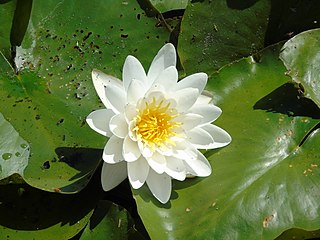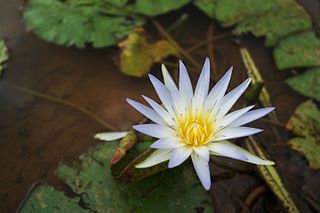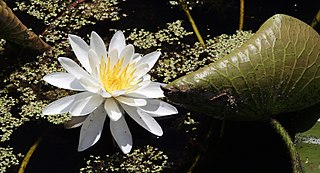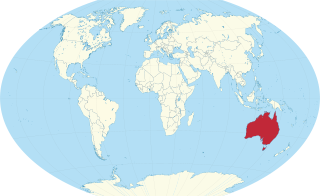
Nymphaea is a genus of hardy and tender aquatic plants in the family Nymphaeaceae. The genus has a cosmopolitan distribution. Many species are cultivated as ornamental plants, and many cultivars have been bred. Some taxa occur as introduced species where they are not native, and some are weeds. Plants of the genus are known commonly as water lilies, or waterlilies in the United Kingdom. The genus name is from the Greek νυμφαία, nymphaia and the Latin nymphaea, which mean "water lily" and were inspired by the nymphs of Greek and Latin mythology.

Nymphaea alba, the white waterlily, European white water lily or white nenuphar, is an aquatic flowering plant in the family Nymphaeaceae. It is native to North Africa, temperate Asia, Europe and tropical Asia.

Nymphaea nouchali var. caerulea, is a water lily in the genus Nymphaea, a botanical variety of Nymphaea nouchali.

Nymphaea lotus var. thermalis is a variety of Nymphaea lotus native to Romania.

Nymphaea odorata subsp. tuberosa is a subspecies of Nymphaea odorata native to the region spanning from Central and Eastern Canada, extending to North Central and Northeastern United States.

Nymphaea micrantha is a water lily belonging to the genus Nymphaea. It is native to the tropics of West Africa.

Nymphaea candida J. Presl is a species of flowering plant in the genus Nymphaea, native to quiet freshwater habitats in Eurasia, it is in flower from July to August. It is sometimes treated as a subspecies of N. alba

Nymphaea nouchali, often known by its synonym Nymphaea stellata, or by common names blue lotus, star lotus, red water lily, dwarf aquarium lily, blue water lily, blue star water lily or manel flower, is a water lily of genus Nymphaea. It is native to southern and eastern parts of Asia, and is the national flower of Bangladesh and Sri Lanka. In Sanskrit it is called utpala. This species is usually considered to include the blue Egyptian lotus N. nouchali var. caerulea. In the past, taxonomic confusion has occurred, with the name Nymphaea nouchali incorrectly applied to Nymphaea pubescens.

Nymphaea ampla, the dotleaf waterlily, is a species of flowering plant in the family Nymphaeaceae. It is native to Texas, Florida, Mexico, Central America, the Caribbean, and northern and western South America.
Nymphaea tenuinervia is a species of waterlily native to Colombia, Guyana and Brazil.

Nymphaea atrans is a species of waterlily is endemic to Queensland, Australia.

Nymphaea heudelotii is a species of waterlily native to the region spanning from tropical West Africa to Uganda and Botswana.

Nymphaea × daubenyana is a species of waterlily endemic to Chad, but has been introduced to Florida, USA. It is a natural hybrid of Nymphaea micrantha and Nymphaea nouchali var. caerulea.

Nymphaea abhayana is a species of waterlily endemic to India.

Nymphaea carpentariae is a species of waterlily native to Queensland and Western Australia.
Nymphaea nouchali var. versicolor is a variety of the water lily species Nymphaea nouchali Burm.f. naturally found in tropical Asia.
Nymphaea nouchali var. petersiana is a variety of the water lily species Nymphaea nouchali Burm.f. native to the region spanning from Tanzania to South Africa.
Nymphaea nouchali var. ovalifolia is a variety of the water lily species Nymphaea nouchali Burm.f. native to the region spanning from West Tanzania to South Africa.

Nymphaea nouchali var. mutandaensis is a variety of the water lily species Nymphaea nouchali Burm.f. endemic to Uganda.

Nymphaea subg. Brachyceras is a subgenus of the genus Nymphaea.


















